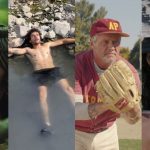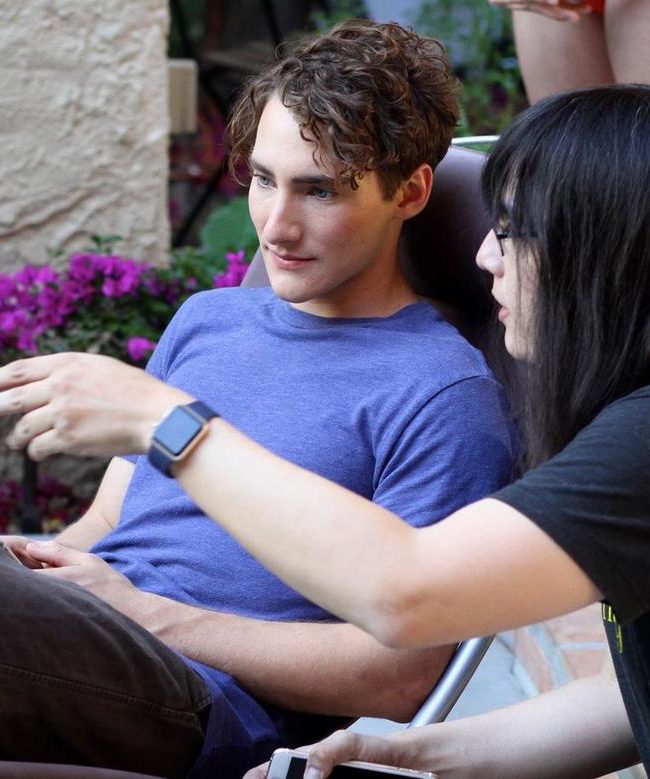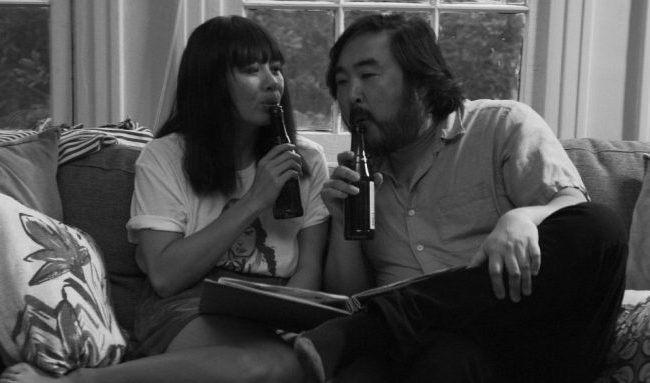A Conversation With Dave Boyle and The Cast Of SURROGATE VALENTINE
Surrogate Valentine, Dave Boyle’s charming new slacker comedy, is currently making the festival rounds (be sure to read Nelson Kim’s review if you haven’t already). For his third feature, Boyle again teamed up with writer Joel Clark and DP Bill Otto, but new to the mix is San Francisco musician Goh Nakamura, a co-creator of the film. Goh plays a character not unlike himself, a singer-songwriter mildly hustling and gigging across the Bay and Northwest, and pining for his high school love Rachel (played by Lynn Chen). A persistent friend convinces Goh to take a job training a handsome TV actor Danny (Chad Stoops) for his upcoming role as a musician, and the unlikely duo hit the road together. Danny then repays the favor as a wingman of sorts when Rachel comes back into Goh’s life. It’s a simple setup with a surprisingly rich payoff thanks to the sharp writing and casting. Boyle and his team also made the most of their digital resources, creating artfully composed black-and-white imagery despite time and budget constraints.
After the film’s SXSW world premiere, I talked with Dave, Goh, Chad, and Lynn about the process of making Surrogate Valentine.
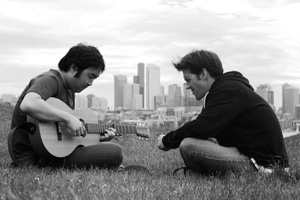 H2N: It seems like a very collaborative effort, I’ve noticed you work with a lot of the same people many times over.
H2N: It seems like a very collaborative effort, I’ve noticed you work with a lot of the same people many times over.
Dave Boyle: On the three features I’ve done so far I’ve had a lot of the same people on my team. Same producer Duane Andersen, same DP Bill Otto. When I start a project… what I usually do is I find somebody that I want to be my lead character and then I try to collaborate with them to build the character. And so this time it was Goh [Nakamura]. I met him at the premiere of White On Rice in 2009, and we really hit it off.
H2N: That was just fortuitous?
DB: Yeah, I’d known his music and stuff, but… it was at the after party, right?
Goh Nakamura: Yeah.
DB: I just kind of went up to him… well, kind of attacked him at a party, and we just hit it off, you know? We spent the rest of night talking at a bar. I just kept running into him, we were releasing White On Rice that year [and] he had just released an album before that, so he was traveling around promoting that. Finally I said, “Why don’t we just work on a project together?” And that’s how this came about. So he became kind of an inspiration for the main character, and then we just decided to have him play himself.
H2N: [to Goh] Had you ever wanted to do film work?
GN: No. [They laugh] To be honest. I’ve worked kind of behind-the-scenes on a lot of film scores and stuff, but if you had told me that I was going to be acting as a lead in a movie two years ago, I’d say you’re crazy. I’m just lucky that Dave had that kind of blind faith in me. Thanks, Dave.
DB: No worries, man. But he just had a quality about him that I thought would be really interesting for a movie. And also the way his music is, it expressed a lot of things that I had always felt but… I’m not the best wordsmith, I’m not very good at expressing myself, so listening to his music was really interesting. And then working with him as a screenwriter was kind of a revelation too. I wrote the first draft of the script with my usual co-writer Joel Clark. And then when Goh came in and started writing, I think maybe it’s his background as a songwriter or something, but he wrote some of my favorite scenes in the movie. Joel and I were saying, “Man, we should just hire him as our writer.” [They laugh] So it was really a collaborative effort. I like collaboration. I definitely know what I want, but I also like to work with people who are strong-willed mavericks. Working with them is kind of like trying to herd cats, but instead of being frustrating it’s rewarding in a lot of ways, because they’re bringing a lot of life to [the film].
H2N: I thought the dialogue was really strong, so it’s interesting to hear you say that. How much was scripted—the performers can speak to this as well—and how much were you improvising on set?
DB: Strictly from the writing standpoint, I did more rewrites on this movie than ever before. The main reason was from a production standpoint—we had to make this movie in 15 days, trying to tailor all of the scenes to take place in a limited number of locations, and taking advantage of resources that we had. Once it was tightly scripted though I tried to let them have some leeway.
Chad Stoops: Pretty big leeway, actually… We did one day, it was great. It was in the park, and Goh’s teaching me guitar. [He laughs] And on the way up I’d been joking in kind of a Christopher Walken voice, and so Dave goes, “Why don’t we just add that into the film?” So we had days like that, that were just kind of fun… And other days Dave would record Goh and I, and then the next day have it all typewritten and say, “Here’s the new script for today.” I mean, word for word… And then working off of Lynn [Chen], and doing different things. Lynn is just a very funny, very accomplished actress. We did a whole scene where… I think some of it was improvised just because I didn’t have the script memorized that day. [They laugh] These guys were great, so easy to work with.
H2N: That translated. It seemed like you all had a very easy, natural vibe, and it felt very real.
DB: Good! [They laugh]
H2N: I was sort of reminded a little bit of a Jim Jarmusch film, he’s cast musicians a lot. Maybe it was the black-and-white as well.
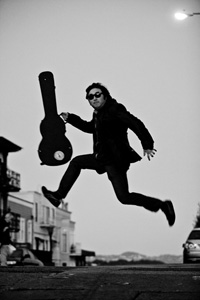 DB: The movie we were thinking of a lot in pre-production was A Hard Day’s Night, but it ended up being a lot less goofy than that. There’s definitely some goofball humor in the film, but it’s a little bit more sullen version… Or one of those retro rock star movies from the ’60s, except our guy, in the film, he’s more of a struggling musician rather than an established pop star. Kind of like if we’d made Jailhouse Rock with Goh instead of—
DB: The movie we were thinking of a lot in pre-production was A Hard Day’s Night, but it ended up being a lot less goofy than that. There’s definitely some goofball humor in the film, but it’s a little bit more sullen version… Or one of those retro rock star movies from the ’60s, except our guy, in the film, he’s more of a struggling musician rather than an established pop star. Kind of like if we’d made Jailhouse Rock with Goh instead of—
GN: Elvis? [They laugh]
H2N: How did you go about casting the rest of the film?
DB: Lynn, we worked together on White On Rice, my previous film. And she’s great, I loved working with her on that. Chad, it’s a little but more of a roundabout story. He was in a short that my DP Bill Otto shot a few years back, and [Bill] was always telling me, “Hey, I have this friend you outta use in a movie.” When I finally met Chad the wheels started turning, and I was like, “Yeah, I’d really like to work with this guy.” So that’s how we met.
H2N: And your DP? I noticed that you’ve worked together numerous times.
DB: Yeah, he’s great. He’s become a really close friend. He was a Craigslist hookup. [They laugh] When I shot my first movie, I didn’t really know how you were supposed to do these things, and I brought him in two days before we were supposed to start shooting. So I met him for the first time basically on the shoot. But we had such a great time, and… our aesthetic, and the way we think about things is kind of similar, but also very different in some ways. I think that having opposing voices, working with people who think a little bit differently than you do, is an advantage in a lot of ways. He sees things that I don’t, and vice-versa. You can’t make a fire without friction, so working with somebody like that is really important to me.
H2N: How much planning did you do before the shoot? Did you do storyboards, shot lists?
DB: No, we didn’t storyboard anything. We’ve slowly gotten away from storyboarding. My first film’s called Big Dreams Little Tokyo, and I storyboarded every shot, “No, we’ve gotta make it like this” kind of thing. Next film, White On Rice, we didn’t do as much, which actually was because we had a locations disaster on that movie. So even if we storyboarded—there was a scene that we were supposed to shoot at a shopping mall, and [we] ended up setting it at a funeral home, lots of things like that. So there was almost no point in storyboarding. But I discovered that I really liked that a lot. And with this film, it was so small and so fast that we had to be flexible about our locations. We tried to shoot as much of it outdoors as we could to take advantage of San Francisco and Seattle. You go outside in either of those cities and it’s like pre-made production design, so we just tried to feel out each scene as it went. Just get the camera up, and watch what [the actors] did naturally without any direction, and then make adjustments accordingly after that.
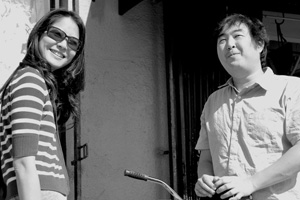 H2N: Did you do a lot of rehearsing? Or how did you prepare?
H2N: Did you do a lot of rehearsing? Or how did you prepare?
Lynn Chen: Actually the first time that Goh and I met was via Skype, for our first Skype rehearsal. So we did a little bit of rehearsing on the Internet. And then we had one or two in-person [rehearsals] with Dave. That’s about it.
H2N: And then you were ready to roll?
LC: Yeah.
DB: We workshopped a lot of the scenes between Goh and Chad. Since both of them have such distinctive voices we didn’t want to stick too close to the script in those scenes. I mean, we discovered early on that it was always better if Goh wrote his own dialogue, just because he…
GN: Because I’m a crappy actor! [They laugh]
DB: No, no. It never sounded right if he said something that me or Joel had written, and, you know, that’s cool. I half-suspected at first that he was purposely saying my dialogue badly so that I’d let him rewrite it. [They laugh] Just kidding. It was a fun time.
H2N: Chad, you had more of a physical comedy, over-the-top style, and it contrasted nicely with Goh’s more deadpan, quiet style. How much of that was natural and how much was a choice?
GN: I was actually thinking about Charles Grodin a lot, how he’s kind of like, “Aaah…” [They laugh]
CS: Were you really?
GN: Yeah. Actually Dave was telling me, “Think of Bill Murray in Lost In Translation, he’s just kind of despairing.”
DB: I don’t think I ever said that. [They laugh]
GN: Yeah you did!
DB: I did sort of pick up cues from him. Because he would do something and I was like, “Wow, that was really good,” and he was like, “Yeah, that was my Charles Grodin impression.” Then the next time, another take, I’d say, “Do Charles Grodin for this take.” [They laugh]
CS: I couldn’t tell when we first started whether he was just—because his character’s actually annoyed with me in the beginning of the film, and then when we would stop filming it would just seem to carry on. [They laugh] And I thought he must be completely annoyed with me altogether. But it actually added some funny things that he said that were thrown in I think out of frustration… because his character has such a dry wit, dry humor.
GN: Low blood sugar?
CS: Yeah, low blood sugar. And mine’s just caffeine, I don’t know. [They laugh]
DB: Goh’s best performances always were when he was hungry. [They laugh] When he was in a bad mood.
H2N: So you deprived him of nourishment?
DB: Yeah, pretty much. Sometimes I’d try and delay lunch a little bit. [They laugh] Whereas Chad was really at his best when he’d been up all night and then had four cups of coffee. [They laugh]
H2N: Where did you find the character who played the record exec, in the house in Seattle with the guns?
DB: Oh that’s him! That’s [Dan Bjornson]. He’s actually my DP’s old bandmate… They were in a band together called The Skidmarks like 20 years ago. Bill and I went up to Alpha Cine in Seattle to color-time White On Rice a couple years ago, and we stayed at Dan’s house, and it was pretty much exactly like that. He’s like, “Hey, come see my gun collection!”… Dan Bjornson is the reason that we decided to set part of the movie in Seattle, so that we could work him into the story, and basically re-enact the time that I went there to stay with him. That was the very last day of the shoot, and we had no idea what to expect, and he just proved to be a force of nature.
H2N: What did you shoot on?
DB: We shot on a Canon XH A1 that we borrowed from my producer Duane’s friend. We used a Letus adapter to use 35mm lenses. We would have liked to shoot on the RED or something a little bit higher grade or whatnot, but this was the kind of film where we were basically borrowing everything. We shot on HDV, which is for all intents and purposes a dead format now, but you know it’s still fine for the right project, and this turned out to be the right project for it. I don’t know if I’d want to do it again.
H2N: It had a cinematic feel.
DB: Good. We shot it in black-and-white because we were going for that kind of retro feel. But it also turned out to be a real budget-saver in a lot of ways, just because we didn’t have to buy gel for lights or anything like that. Bill and I are both totally stoked about how it looks, especially considering the resources that we had to work with. But coming from White On Rice,where we were shooting on film, to this—it was basically a choice of either make it this way, or not make the movie at all, so it’s a no-brainer.
H2N: Mumblecore films have similar characters in a way—young people establishing themselves and whatnot, a San Francisco or Brooklyn vibe—but they’re loosely scripted. I was curious about the choice you and the performers made to have that subject matter but move back toward more traditional narrative films.
DB: We definitely wanted to have a traditional movie. We wanted people to be able to watch it and be like, “This is a movie, it tells a story with a beginning, middle, and end.” That’s just a personal taste thing for me, the kind of movies that I want to make. I watch mumblecore films and enjoy things that don’t have any plot in them… But in the movies I make I prefer more plot-driven stuff.
CS: A tribute to Dave is he can really just tightrope-walk that line between those two [types of] films. He’s so good at allowing his actors to improvise… Dave was really good at saying, “Well, we can’t really have this, but… I like what you’re improvising, go down this road.”… It takes a lot of discipline, and I think it takes a lot of trust in his actors.
DB: Even though sometimes I felt like we were throwing out the script, when I went back afterwards and was looking through the script it was actually pretty close. There were definitely places where we departed and scenes that we added on the fly or whatever, but overall I think we pretty much shot what we scripted.
H2N: What is next for you all?
GN: We’re working on a sequel right now that we’re going to shoot in August, right?
DB: Yeah… It’s kind of fun to do projects like this that are more personal in between the bigger projects where you’re actually getting paid. I kind of call it “the world’s smallest movie franchise.” Goh and I really like working together, so we wanted to catch up with his character a couple years down the road, and have a new set of adventures. And hopefully we’ll be able to keep working together on stuff.
— Susanna Locascio

